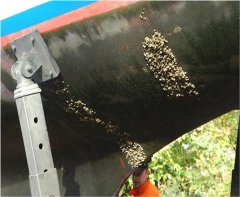May 11 2009
Researchers at the University of Gothenburg, Sweden, have been working with the Swedish Chemicals Inspectorate and paint manufacturers on a new, low-emission, environmental hull paint based on a new principle called Post settlement inhibition (PSI). The paint is almost 100 percent effective in keeping barnacles away. An extension of the new principle may be to further develop paints that will be effective against all hull-fouling, without damaging marine organisms in the open water and sediment.
 The hull of a yacht painted with paint containing PSI substances, compared with an untreated control surface. Observe the dense covering of barnacles on the rectangular control surfaces. The boat has been sailing in the sea-water along the west coast for four months during the summer 2008. Photo: Jesper Löve
The hull of a yacht painted with paint containing PSI substances, compared with an untreated control surface. Observe the dense covering of barnacles on the rectangular control surfaces. The boat has been sailing in the sea-water along the west coast for four months during the summer 2008. Photo: Jesper Löve
Most commercial anti-fouling paints contain pesticides, which slowly erode into the water, either killing off or discouraging organisms that try to attach themselves to the surface. One of the most commonly used substances is copper, which means that around 40 tonnes of copper are distributed along the Swedish west coast every year.
New principle
Researchers at the University of Gothenburg have been working in association with the Swedish Chemicals Inspectorate and paint manufacturer International Paint AB, as well as others, to develop a new principle for effective hull paints, called "post settlement inhibition", or PSI. This principle also uses pesticides, but unlike other paints that are harmful to the environment, the PSI substances are strongly associated with the paint's binding matrix agent, so that only tiny amounts are released into the marine environment. Adding a high-molecular solvent to the paint helps to channel the substance directly to the organism instead.
Very effective
The paint allows the barnacles to colonise on the hull with its larva. The anti-fouling effect begins to kick in when the barnacle tries to attach itself more tightly to the surface and comes into contact with the pesticide, which causes it to release its grip (hence the term, "post settlement inhibition"). The emission of pesticide in the environment is at the same time very low. Extensive tests conducted with volunteer boat-owners reveal that the PSI principle is very effective. Barnacle colonisation is reduced by at least 90, but often up to 100 percent.
Natural models
The principle has taken its inspiration from the natural world, where certain types of algae use a similar method to discourage fouling on the surface of their leaves. The new PSI paint releases negligible amounts of pesticide into the marine environment, and the amount of pesticide that is actually in the layer of paint is relatively low. When the boat is taken out of the water, the PSI paint can be scraped off and dealt with according to the procedures that are in place at most marinas.
"In the long term, we are hoping to be able to use the PSI principle to tackle fouling by other animals and algae. The ultimate goal is a marine paint formula that is effective against all kinds of fouling, but that has a negligible impact on other organisms in the marine environment," says leader of the project Professor Hans Elwing at the Department of Cell and Molecular Biology, University of Gothenburg.
Patience and luck
The breakthrough in the paint project came when researchers discovered the special solvent that is part of the PSI system. "We were very lucky to make the discovery. At the same time, it's taken us ten years of research to get where we are today. The journey has been peppered with failures, but my colleagues have also been passionate about this project, and there has been considerable enthusiasm from boat owners," says Hans Elwing.
The new PSI principle is being developed in cooperation with a research programme called MARINORD, which is being financed by NordicInnovation. The project is being sponsored by the Technical Research Institute of Sweden in Borås, and several paint companies.